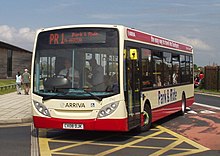Alexander Dennis Enviro200
| Alexander Dennis Enviro200 | |
|---|---|

Arriva North West & Wales Enviro200 in Southport
|
|

Interior of the Enviro200
|
|
| Overview | |
| Manufacturer | Alexander Dennis |
| Production | 2003–present |
| Body and chassis | |
| Doors | 1 or 2 doors |
| Floor type | Low floor |
| Chassis | Alexander Dennis Enviro200 MAN 14.240 BYD K9 |
| Powertrain | |
| Engine |
Cummins ISBe (ADL Enviro200) MAN D0836 LOH 52 (MAN 14.240) |
| Capacity | Various, dependant on length and specification |
| Power output | 140 horsepower (100 kW) to 240 horsepower (180 kW) |
| Transmission | Allison, Voith, ZF |
| Dimensions | |
| Length | 8.9 metres (29 ft) to 11.8 metres (39 ft) |
| Width | 2,440 millimetres (8.01 ft) |
| Height | 2,860 millimetres (9.38 ft) |
| Curb weight | 13–14.4 tonnes |
| Chronology | |
| Predecessor |
Dennis Dart SLF Alexander ALX200 Plaxton Pointer Alexander Dennis Enviro300 |
The Alexander Dennis Enviro200 (previously known as the TransBus Enviro200) is a midibus manufactured by TransBus International and later Alexander Dennis since 2003. The original TransBus Enviro200 design was innovative but ultimately unsuccessful, with few being sold before the introduction of the second generation Enviro200 (originally referred to as the Enviro200 Dart) revived sales for the product from 2006. It was supposed to be positioned in between a minibus and a rigid single-decker bus.
The Enviro200 was originally designed to be the replacement for the Dennis Dart SLF chassis and Alexander ALX200 and Plaxton Pointer 2 bodies. In 2014, a third generation version of the Enviro200 was launched, known as the Enviro200 MMC, replacing the original Enviro200 and Enviro300.
A license-built version of the Enviro200 is built and marketed in North America by New Flyer Industries, as the New Flyer MiDi.
The first generation Enviro200, then known as the TransBus Enviro200, was unveiled at Coach & Bus 2003 by the vehicle's then-manufacturer, TransBus International. Two diesel trial buses were initially produced for display in 2003.
The first generation Enviro200 was unique in that it had a door both at the front and at the rear of the bus, as such a layout is rare in the UK - most dual-door buses in the UK have a door at the front and another door around the centre of the bus. This door layout was achieved by placing the engine vertically at the rear offside together with other driveline components, which also created a full low floor layout, common on buses in Continental Europe. The vehicle also incorporated an "Enviro Pack", intended to vent exhaust emissions, noise and heat away from ground level and thus alighting passengers.
...
Wikipedia
